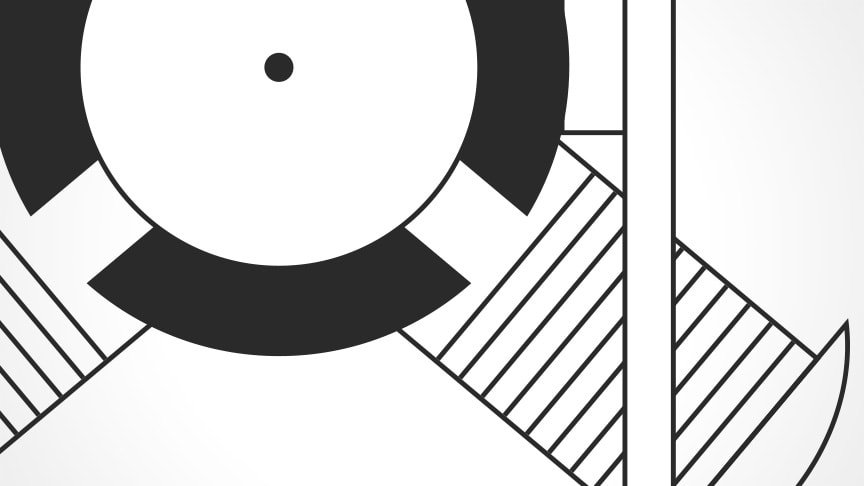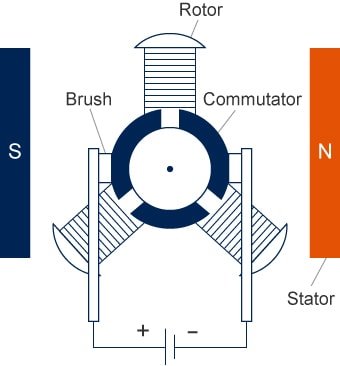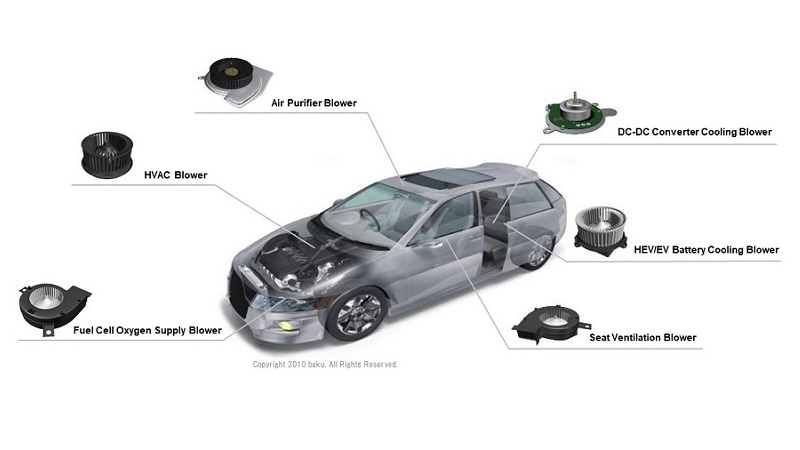How do brushed DC motors work? The need for regular maintenance explained
-
Automation
-
Health & wellness
-
Life environment
-
Automotive

18 Feb. 2021
DC motors are electric motors that are powered by direct current. Features include the ability to run at high speeds, and high starting torque. They can broadly be divided into two groups. This page provides a simple introduction to the brushed DC motor and how they work.
DC motors are broadly divided into two types
Electric motors can be divided into a number of different types based on their structure and how they are driven. AC motors are driven by alternating current, stepper motors rotate in fixed steps each time a pulse of electric power is input, and DC motors are driven by direct current. Compared to the other types, the benefits of DC motors include being able to operate at high speeds and delivering high starting torque.
DC motors can be further divided into brushed DC motors and brushless DC motors. The operation of brushed DC motors is based on the mechanical linkage between their commutator and brushes. Brushless DC motors, on the other hand, do not have a commutator and brushes, and instead are electronically controlled with a drive circuit. The main features of DC motors are as follows.
- Ability to operate at high speeds
- High starting torque
- Motor speed and torque can be controlled by voltage
A feature specific to the brushed DC motor described here, is that they do not require a drive circuit in applications where speed control is not needed.
The following link provides more details about the differences between brushed and brushless DC motors:
What are the differences between brushed and brushless DC motors?
Permanent magnet motors and electromagnet motors
Brushed DC motors are further divided into two types based on the type of magnet they use.
- Permanent magnet motors
- These motors, which use a permanent magnet to generate the magnetic field, are the most common form of electric motor used worldwide, being used in toys and models as well as in the auxiliary motors of automobiles. They have a permanent magnet stator, and coils for the rotor.
- Electromagnet motors
- These motors use an electromagnet to generate the magnetic field. They are further divided into distributed-winding, series-wound, and separately-excited motors depending on how the field winding and armature winding are coupled. They are widely used in sizes that range from medium-sized electric motors of around 1 HP up to very large motors.
The choice of motor type is determined by the application and required motor size.
How brushed DC motors work
Next, let’s look at the features of brushed DC motors and how they work. Brushed DC motors have wound coils in the rotor, which are surrounded by magnets contained in the stator. The two ends of a coil are connected to the commutator. The commutator in turn connects to electrodes called brushes, resulting in the flow of direct current electric power through the brushes and coil for as long as the brushes and commutator are in contact.
As the coil rotates, however, it reaches a position where the brushes and commutator are no longer in contact, halting current flow in the coil. Despite this, the momentum of the coil causes it to continue rotating. This brings the brushes and commutator back into contact, restoring the current that now flows through a different coil.
This repeated switching of current flow causes the brushed DC motor to continue rotating. Brushed DC motors operate on direct current, and their speed can be easily controlled by altering the applied voltage.

Brushes and commutator are consumable parts
As explained above, brushed DC motors deliver high starting torque and can operate at high speeds despite their simple structure. They are also easy to use, being able to operate without a drive circuit if speed control is not needed. However, brushed DC motors have the following disadvantages.
- A tendency to generate electrical and acoustic noise
- A short life and a requirement for regular maintenance
The brushes and commutator in a brushed DC motor are in continual contact with one another as the motor rotates. This is what causes the electrical and acoustic noise.
The short life of these motors is another important consideration. The continual contact between brushes and commutator as the motor rotates causes these parts to gradually deteriorate by friction-induced wear. As the metal brushes wear down, their contact with the commutator diminish, and no longer do a good job of conducting electric power. As a result, the motor will no longer work properly. This explains why the brushes and commutator are consumable parts, requiring maintenance in the form of regular inspection or replacement.
Maintenance is a necessity for brushed DC motors due to the way they work
DC motors are divided into brushed DC motors and brushless DC motors. Brushed DC motors work by having the coil rotate inside the surrounding magnets. The rotation of the coil causes the contact between commutator and brush to alternate, therefore switching the current flow through the coil. As a result, the brushed DC motor can operate.
Despite its simple structure, the continual contact between the brushes and commutator as the motor rotates causes wear, and this creates a need for regular maintenance to replace worn parts.
List of the same series columns
- Applications for blower motor
- What is a blower motor?
- Advantages of brushless DC motors over brushed DC motors
- Features and applications of DC motors
- Is this brushless motor cheap or expensive? - What factors determine its price?
- Different types of DC motor and their respective features
- What is a geared brushless DC motor?
- How does an electronic speed controller for a brushless DC motor work? And what should you consider when you choose the right one?
- Small brushless motors
- Difference between brushed motor and brushless motor
- What are the disadvantages of brushless DC motors? And how can they be overcome?
- Advantages of brushless DC motors: How they differ from brushed DC motors
- What is an actuator?
- How do brushless DC motors work? The need for a drive circuit explained
- Do brushless DC motors require a drive circuit? – Controlling brushless DC motors
- What is a brushless DC motor?
- Brushless DC motor applications: examples that demonstrate their features
- Stepper motor applications: Examples that demonstrate their features
- Motors designed for easy control: How do stepper motors work?
- What are the differences between brushed and brushless DC motors?
- What is a PSC motor
- What is a servo motor?
- What is a blower?
- What is a DC motor? - features and mechanisms
Contact us for more information
- New inquiry
- Prototype
- Upgrade
- Customization
- Your spec
- Literature
- Support
- Others













